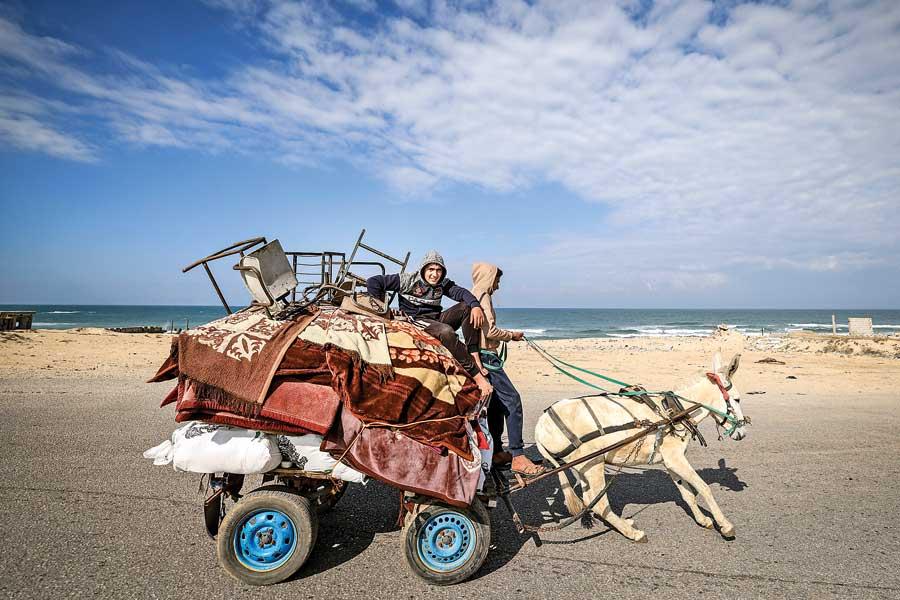Reply To:
Name - Reply Comment

Palestinians fleeing Khan Yunis on a donkey cart with their belongings as Israel pressed its blistering assault on the city yesterday. AFP
As Israel’s inhuman onslaught on the Gaza Strip continues, the talk of a two-state solution is being bandied about by world leaders, especially those from the Global South.
Though the two-state solution requires thorough scrutiny and resurrection, some see this as an attempt to deflect global attention from the Gaza horror, which has killed more than 25,000 people; 70 percent of them being women and children. Whether this horror is gross genocide will be known today when the International Court of Justice delivers its provisional order.
Irrespective of the World Court’s ruling, Israel, it appears, has no intention to end its terror in occupied Palestinian territories, as was evident two days ago in its heritage minister’s reiteration that Gaza should be nuked. Israel’s genocidal intention is also evident in its hardline Prime Minister Benjamin’s point-blank rejection of calls for a ceasefire.
Israel’s solution is war in which its adversaries are Palestinian children, women, the elderly, and unarmed civilians, with Hamas being the collateral damage. Going by the Israeli leaders’ statements, it appears that until there are no more Hamas members to die as collateral damage, Israel’s war on children, women, and civilians will continue.
Sarcasm apart, bringing the two-state solution from the back burner to the front may seem a little out of step, given the ceaseless death and destruction in Gaza. The immediate need is a ceasefire. The two-state solution is for the day after. But about the day after, Israel and the rest of the world hold different views.
For Israel, the day after will not dawn until Hamas is eliminated. After more than 110 days of intense bombing that had no parallel in any other war theatre in modern history, Israel has miserably failed to achieve the war’s objective: the elimination of Hamas and other resistance groups.
For the rest of the world, minus Israel’s hardcore genocide cheerleaders such as the United States, Britain, and Germany, the day after should follow an immediate ceasefire leading to talks that will eventually bring about a Palestinian state existing side by side with Israel in peace and harmony.
Such a ‘day after’ was the call of the Global South when its leaders met in the Ugandan capital of Kampala for the Non-Aligned Movement and G77+China summits last week. Among them was Sri Lanka’s President Ranil Wickremesinghe, who has of late been more vocal about justice for Palestinians and a two-state solution. Injecting a dose of practicality, he set a five-year roadmap to navigate the obstacles and arrive at such an eventuality.
The president’s proposed five-year timeline brings back painful memories of the failed Oslo Accords of 1993 and 1995.
The Oslo Accords outlined a plan to set up a Palestinian state within five years. However, the establishment of such a state based on the UN Security Council resolutions 242 and 338—which settled for the 1967 borders, thus veering away from the 1947 UN General Assembly resolution 181—could not be realised largely because Israel kept shifting the goalposts each time the Palestinian side met the Oslo deal’s conditions.
The last of such conditions was that Palestinians recognise Israel as a Jewish state, a euphemism for a state exclusive to Jews. Such recognition, the Palestinians fear, could give Israel a justification to expel its Arab citizens—almost 20 percent of Israel’s population—to the West Bank after stripping them of their Israeli citizenship.
The two-state solution is largely a charade that Israel, with the backing of the US and some powerful European states, used to mislead the world community into believing that it is ready to negotiate peace with Palestinians. Israel also used it as a tool to divert the world community’s attention from its land-grabbing and settlement-building programmes in Palestinian territories.
Since the Oslo Accords, Israel’s illegal settlement-building activities in the West Bank have more than doubled. The US and Israel’s European allies would issue pro forma condemnation and would not take any serious measures to dissuade Israel from building these illegal settlements.
These illegal Jewish settlers have become a law unto themselves. They kill Palestinians and when arrested, they get discharged due to a “lack of evidence” or given a light punishment.
With the call for a two-state solution gathering some momentum, Israel is faced with three choices:
1: The two-state solution, which the international community supports and is acceptable to the Palestinians.
2: The one-state solution or a merger with Israel: the Palestinians are willing to consider it, provided that such a state is democratic and recognises the Palestinian refugees’ right to return.
3: Continue its oppressive policy with genocide and apartheid laws until the Gaza Strip and the West Bank are cleansed of Palestinians.
Of these options, Israel has chosen the third, as has been evident in its genocidal action in occupied Palestinian territories.
Moreover, for the two-state solution to be viable, several obstacles need to be surmounted. They include Zionism, which dreams of establishing Eretz Israel or Greater Israel, whose borders extend from the Nile in Egypt to the Euphrates in Iraq.
Another key obstacle is the support Israel receives from the United States. As though it were under a spell, Washington has been protecting Israel with military and economic assistance and the use of veto power to defeat anti-Israeli resolutions at the UN Security Council.
The mushrooming illegal settlements and the rise of Jewish extremism in Israeli politics are also peace killers.
The status of Jerusalem is another major challenge. It is claimed by all three major Abrahamic religions: Judaism, Christianity, and Islam. Besides, these religions propound conflicting eschatological narratives about Jerusalem. The Jews expect the birth of a final messiah and the building of the fourth temple. When this happens, they believe the world will embrace Judaism. The Christians await the second coming of Jesus Christ, and when this happens, the Jews and the rest of the world will embrace Christianity. The Muslims also believe in the second coming of Christ, who they say will give leadership to the Muslims, defeat the anti-Christ, and urge people to join Islam.
Then there are other issues to be dealt with. They include the right of the Palestinian refugees to return to their villages from which they have been expelled; the borders of the Palestinian state; and last but not least, the discord among Palestinian factions, especially the rivalry between the Palestinian Authority and Hamas.
If President Wickremesinghe is serious about his two-state peace plan, then he should back China’s call for an international conference to explore a two-state solution. President Xi Jinping has urged that the solution to the Palestine question be comprehensive, just, and sustainable. Russia is backing China’s call and has blamed the US for deliberately scuttling an earlier international effort through the quartet comprising the US, the UN, the European Union, and Russia.
Unsurprisingly, the US is not inclined to support a China-led international effort.